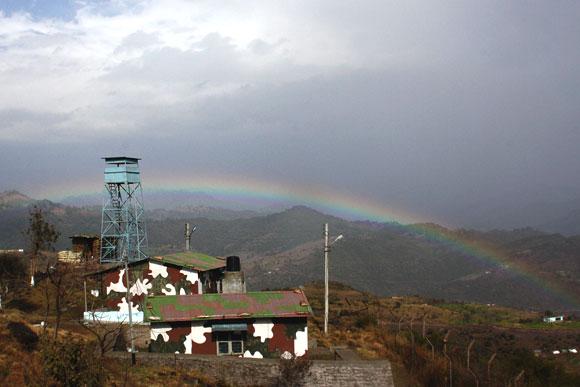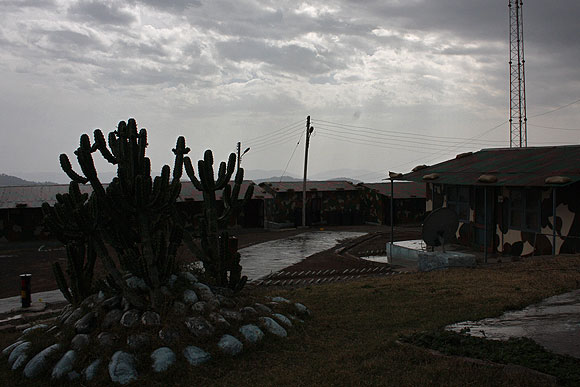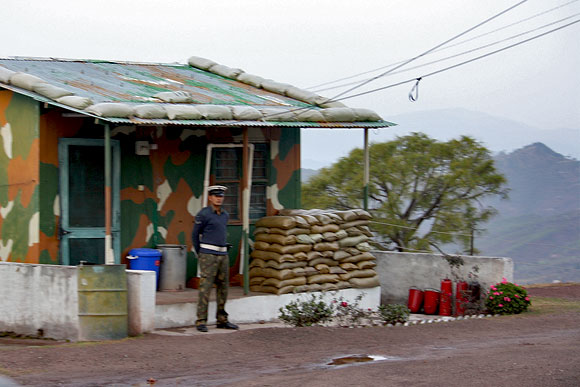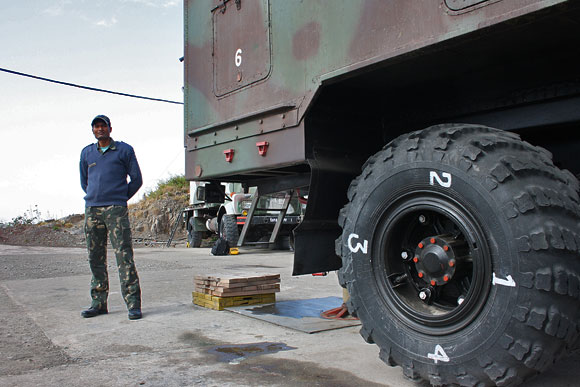Far from civilian populations, facing the onslaught of weather, terrain and a hostile neighbour in the distance, the young men at one of the Indian Air Force's most strategic locations near the Line of Control say life is hard, but tell Rediff.com's Archana Masih they would not have it any other way.
Photographs: Rajesh Karkera/Rediff.com
Photographs: Rajesh Karkera/Rediff.com
Also See: Salute the Soldier at the LoC
Up a desolate climb, the road lined with fir trees winds up to a fortified hill from where the Indian Air Force guards India's skies near Pakistan.
"If any aircraft comes near the Line of Control, we have to report it immediately," says Flight Lieutenant Pankaj Singh Malik, 24, who has spent the last nine months of his first posting here, at one of the IAF's most strategic radar locations in Jammu and Kashmir.
Armed men posted on tall observation towers guard this IAF base round the clock, protecting the camouflaged radar that monitors the sky on either side of the Line of Control.
The radar we are at is not far from the LoC -- the cease-fire line that seperates India and Pakistan in Jammu and Kashmir -- and has a range that can see within Pakistani territory bordering India.
Less than 50 kilometres away is an area which was a hotbed of terrorism until two years ago. Militancy is under control, but a large troop presence indicates that in J&K soldiers can't afford to let their guard down.
"We report the coordinates of any unidentified aircraft or any aircraft which has strayed from the established flight path. It is then identified and communicated with," says Squadron Leader P Raghunath, 34.
In the event of an armed aircraft entering Indian air space, fighter jets are scrambled and airborne in minutes.
The last time Indian MiGs shot down Pakistani military aircraft was in 1999 -- at the height of Indo-Pak tensions a month after the Kargil conflict -- when a Pakistani naval reconnaissance aircraft with 16 men on board invaded Indian air space in Gujarat.
International convention certifies that if an aircraft does not follow instructions to force-land, it is deemed hostile and can be shot down. Further, a treaty between India and Pakistan states that military combat aircraft have to keep a minimum distance of 10 kilometres from the border.
During the Kargil conflict in 1999, Pakistan shot down an Indian MiG-21 and a Mi-17 helicopter. MiG pilot Squadron Leader Ajay Ahuja was awarded a Vir Chakra posthumously for his rescue attempts to locate the pilot who had ejected in an area dominated by Pakistani infiltrators.
The Mi-17 helicopter on a mission in the icy heights of Tololing was struck by a Stinger missile. Its crew -- Squadron Leader Rajiv Pundir, Flight Lieutenant S Mulihan, Sergeant P V N R Prasad and Sergeant R K Sahu -- had conducted nine daring strike-missions over two days. They were awarded medals for gallantry posthumously and a memorial remembers their heroism at the Sarsawa air force station in Uttar Pradesh.
Sergeant Sahu, the youngest among these heroes, was 28, the only son of his parents.
The weather throws a new challenge everyday
Far from the civilian population, the men at this radar station live away from families, without much contact with the outside world -- serving at a station designated as a 'hard posting,' where the weather throws a fresh challenge almost everyday.
Frequent gales have to be battled along with lashing rain that comes down hard, rattling the tin roofs fastened with sandbags to make them extra secure.
The strong winds are often accompanied with a biting chill factor and huge lightening arrester equipments are used to counter thunder storms.
Here, nature often displays all its varying facets in a single day -- hail, rain, cold, sunshine, even a rainbow. "I have been less than a year here, but I have seen all the seasons during this time," says Flight Lieutenant Pankaj Malik, who hails from Bhopal and is the first member of his family and among his friends to join India's armed forces.
In the surrounding area, there are other IAF units which do not even have road connectivity and are maintained entirely by air support.
The walk to one such site is almost 14 kilometres long.
The availability of water poses the other big challenge, perhaps even bigger than the weather and terrain. The water point is situated 30 kilometres downhill from where it is pumped up. While the radar equipment and other essential facilities have generators as back-up, the pumping of water is dependent on state government-provided electricity.
On days when the power is paltry or non-existent, water bowsers with armed escorts -- in keeping with the sensitive security situation -- have to be deployed to fetch the water.
Any vehicle that goes out does so under armed escort; airmen with AK-47 rifles accompanying the convoy to prevent a terrorist attack.
We feel proud to be guarding the skies'
"It can get quite hard here, but we feel proud to be guarding the skies bordering Pakistan," says Corporal Rajinder Kumar, a native of Bihar, sitting in the dining hall with men hailing from different states -- Andhra Pradesh, Tamil Nadu, Madhya Pradesh, Maharashtra, Uttarakhand, Uttar Pradesh... a mini India that assembles to eat together at that table everyday.
Their days begin at 6 am and ends around 10 pm. The men's dormitory is made of pre-fabricated huts assembled at the site, each man is assigned a bed and cupboard each; the schedule for the day is pinned on a common board on the wall. Washing machines, water purifiers are provided; the men stay in touch with their families via cellphones.
In the higher reaches, at other radar locations, airmen live in shelters built like igloos made of fibre reinforced plastic, housing 4 to 6 men. The snow cutting them off from road connectivity for months on end.
'You never know how long peace can last'
"So quiet is it here that you can hear a vehicle way down the hill, kilometres away," says another airman."When we go to the city it all seems very noisy."
When off duty, the men play volleyball if the weather permits or indoor games like table tennis and carom. A television in the airmen mess, a library, video etc keeps them entertained in their free time, but life does get lonely at the station which stands like a silent sentinel in a landscape far removed from a town or a village.
Annual leave has to be applied three months in advance and for some airmen it is a long journey back home.
"My hometown is 3,250 kilometres away. It takes three days to go and three to return," says a young airman who hails from Salem, Tamil Nadu.
"The last two days before the leave ends are very sad. The train ride back is always done with a heavy heart," continues the corporal who has been posted here from Gwalior, Madhya Pradesh, pointing out that it took him three months to adjust to the harsh winter in Jammu and Kashmir compared to the blistering heat of central India.
'Pakistan's attitude can change any time'
As they sip their tea, the men recount how they don't reveal what they do or where they work to fellow passengers while on the train.
"We just tell them we have a government job," says Corporal Neel Kandan from Tamil Nadu, a young man in his early 20s who jokes about not having the opportunity to see any girls since he is posted at such an isolated location.
There are other veterans -- ex-infantry men -- from the Defence Service Corps posted at the station. Men with the experience of serving in Kargil, Drass and other high altitude areas who have lived almost their adult life in the armed forces.
"We've served so many years in the fauj, this is our life now," says Naib Subedar Ramdas Bansode, a resident of Solapur, Maharashtra.
Some air force stations along the LoC get a fair amount of support from army units nearby and vice versa with some army units dependent on the IAF for their food supplies at locations like the Siachen Glacier.
Stationed close to a hostile border, the men here know that peace is fragile even though incidents of infiltration have reduced recently.
"Pakistan's attitude can change any time," says a 25-year-old corporal. "It is a safe haven for terrorists. You never know how long peace can last."
As they keep a vigil on the sky at the frontline, away from human habitation, facing the onslaught of weather, terrain and a hostile neighbour lurking in the distance, they say life is hard, but they would not have had it any other way.
"Life is difficult, but overall not so bad!" says an air force officer, "We are a happy bunch willing to do anything to make sure that the skies are free from the enemy."
Morale is a vital weapon in any soldier's arsenal, and at the small air base on a lonely hill along the LoC, there seems to be no dearth of it among the young band of officers and their men.
source:








0 comments:
Post a Comment